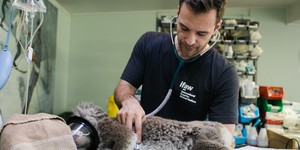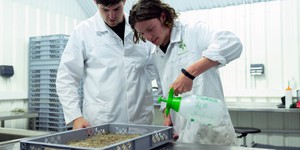Abstract
As your mom and dad always tell you, a healthy diet is important to good health. This project is designed to see what happens to mice when they are allowed to load up on sugary snacks. Do you think that they will gain excess weight? Do you think that the mice will regulate their own intake and maintain a 'healthy' diet? You can try this project and find out for yourself.Summary
Sources The original idea for this project is from:
- Levy, K.M. (2004). How Dietary Sugar Affects the Weight Gain of Baby Mice. California State Science Fair Abstract. Retrieved August 11, 2006 from http://www.usc.edu/CSSF/History/2004/Projects/J1010.pdf.
Information on marking mice is from:
- Jackson Laboratory. (2006). Ask the Vet: What animal identification systems can be used for mice? The Jackson Laboratory, Bar Harbor, Maine. Retrieved August 20, 2013, from http://jaxmice.jax.org/jaxnotes/archive/500h.html
Information on handling mice is from:
- Collin Country Community College District. (n.d.) Laboratory Mouse Handling and Restraint: A 10-Step Reference. Retrieved August 20, 2013, from http://iws.collin.edu/biopage/mouse%20tutorial.pdf
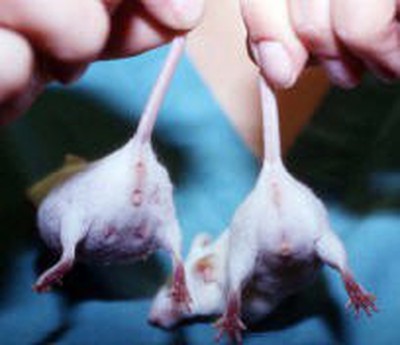
Objective
The goal of this project is to determine whether feeding juvenile mice supplements of different food types would lead to increased weight gain.Introduction
When speaking about proper nutrition, we often use the word 'balance.' You often hear, for example, how important it is to eat a balanced diet. Health-conscious people also strive to maintain a balance between calories consumed and calories expended, by getting regular exercise and eating regular, healthy meals.
What happens when the diet is imbalanced? Can consumption of too many simple carbohydrates lead to weight gain? How about other types of food? These kinds of questions can be difficult to answer with studies on humans, since it would be unethical to knowingly subject experimental subjects to unhealthy diets. As an alternative, scientists can conduct epidemiological studies, looking at health outcomes for groups of people with different dietary habits. Another method is to use animal models for more carefully controlled experimental studies.
Mice are often used as experimental animals for many reasons. One of the biggest reasons is the degree of control that scientists have over the genetic backgrounds of the mice they study. Specific genes of interest can be turned off or on, or regulated more subtly. Also, since mice grow quickly, it is easy to generate sufficient numbers of mice with similar genetic backgrounds.
Small, warm-blooded animals, such as mice, generally have much higher metabolic rates (and shorter lifespans) than larger warm-blooded animals. Typical laboratory mice live about one and a half years. Mice are considered infants from birth to 21 days of age. At 21 days they are weaned—they stop nursing and switch to eating solid food. Mice are considered juvenile from 3–8 weeks. At 2 months, mice are considered adults, and are capable of producing offspring (NIDDKD, 2005b).
Even though mice have many genetic and biochemical similarities with humans, experimental outcomes with mice are certainly not guaranteed to be similar to experimental outcomes with humans. Still, experiments with animal models can provide us with many valuable insights to help fight human diseases.
Terms and Concepts
To do this project, you should do research that enables you to understand the following terms and concepts:- protein,
- fat,
- carbohydrate.
- What is the nutritional composition of standard laboratory mouse food (mouse chow)?
- What is the nutritional composition of the sugared cereal supplement?
- What are some of the mechanisms by which the body maintains its energy balance?
Bibliography
- For ideas for experimental design and practice with analyzing data, this site has web-based experimental simulations on the science of energy balance (see especially lesson 4, "Munching Mice", requires Flash Player):
NIDDKD, 2005a. "The Science of Energy Balance," National Institute of Diabetes and Digestive and Kidney Diseases, National Institutes of Health [accessed August 11, 2006] http://science.education.nih.gov/supplements/nih4/energy/activities/activities_toc.htm. - NIDDKD, 2005b. "Munching Mice Reference Manual," National Institute of Diabetes and Digestive and Kidney Diseases, National Institutes of Health [accessed August 11, 2006] http://science.education.nih.gov/supplements/nih4/energy/activities/508/mice-ref/mice_ref.htm.
- This website has descriptions and calculators for several statistical tests, including the Student's t-test that you can use in this project:
Kirkman, T., date unknown. "Student's t-Tests," Department of Physics, College of St. Benedict & St. John's University [accessed February 23, 2006] http://www.physics.csbsju.edu/stats/t-test.html.
Materials and Equipment
To do this experiment you will need the following materials and equipment:- at least a dozen juvenile mice of the same age (between 3–6 weeks old),
- at least two separate cages with sufficient space for the mice;
- bedding material;
- mouse food;
- place to keep cages with normal light/dark cycle and reasonably constant temperature;
- food supplement: sugared cereal for group 1;
- latex or vinyl examination gloves (wear when handling mice);
- electronic scale, for weighing mice, such as the Fast Weigh MS-500-BLK Digital Pocket Scale, 500 by 0.1 G, available from Amazon.com;
- weighing chamber.
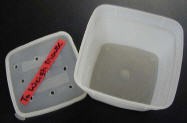 Image Credit
Image Credit
Figure 1. To prevent mice from escaping when weighing them, use a weighing chamber. This one is made from a refrigerator container with air holes punched in the top.
Disclaimer: Science Buddies participates in affiliate programs with Home Science Tools, Amazon.com, Carolina Biological, and Jameco Electronics. Proceeds from the affiliate programs help support Science Buddies, a 501(c)(3) public charity, and keep our resources free for everyone. Our top priority is student learning. If you have any comments (positive or negative) related to purchases you've made for science projects from recommendations on our site, please let us know. Write to us at scibuddy@sciencebuddies.org.
Experimental Procedure
- Place six mice in each cage. Both groups will have free access to standard laboratory mouse food and water.
- Feed the mice in cage 1 a supplemental food high in simple carbohydrates (e.g., sugared breakfast cereal) two or three times a day.
- Mice in cage 2 (the control group) will receive no supplement.
- Record the weight of each mouse daily. How do you tell them apart? Here are some tips for marking mice from the mouse experts at The Jackson Laboratory:
- "Several methods are particularly well suited for identifying cage mates. A felt tip marker may be used for marking an ear or tail: such marks usually disappear in 1-2 days.
- "Food coloring may be used to dye a patch of fur: such marks generally last for 1-2 weeks but can be used only on albino and light colored mice.
- "A patch of fur on the back or side of the mouse may be shaved: such marks generally last 1-4 weeks (depending on stage of the hair cycle) and can be used on any color mouse." (Jackson Laboratory, 2005)
- For handling the mice in order to weigh them, there are three different methods you can try. Whichever method you choose, transfer the mouse to the weighing container smoothly and quickly.
- If you can manage the hand scoop method, it is probably the least stressful for the mice. However, you do need to be careful not to let the mouse escape.
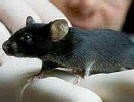 Image Credit
Image Credit
Figure 2. The hand scoop method is usually the least stressful way of handling mice.
- The tail hold with hand support is the next method. Grasp the tail of the mouse close to the body (no further than half-way down the tail). Support the mouse's feet with your other hand.
 Image Credit
Image Credit
Figure 3. The tail hold with hand support is an alternative method for handling mice.
- The tail hold alone is the final method. Remember to always grasp the tail of the mouse close to its body. Lifting near the tip of the tail will injure the mouse. Do not leave the mouse hanging, or it will climb its tail and try to bite.
 Image Credit: Colin County Community College District / Copyrighted
Image Credit: Colin County Community College District / Copyrighted
Figure 3. The tail hold alone is the third method for handling mice.
- If you can manage the hand scoop method, it is probably the least stressful for the mice. However, you do need to be careful not to let the mouse escape.
- Calculate the weight gain for each individual mouse.
- Calculate the average and standard deviation of the weight gain for each group of mice.
- More advanced students should use Student's t-test to determine whether any differences between the two averages are statistically significant. The Bibliography has a link to an online calculator you can use (Kirkman, date unknown).
Ask an Expert
Global Connections
The United Nations Sustainable Development Goals (UNSDGs) are a blueprint to achieve a better and more sustainable future for all.
Variations
- If you want to collect data on caloric intake, you can also weigh the food each day to figure out how much the mice have eaten.
- In this experiment, the food supplements primarily contained simple carbohydrates. What about other nutrients? Design an experiment to test weight gain when the food supplement contains a high proportion of fat, or protein.
- When it comes to gaining or losing weight, diet is only part of the equation. Diet determines the number of calories on the input side, but an animal's activity determines how many of those calories are used. Design an experiment to assess the difference in weight gain between "couch potatoes" and active mice.
- What role does genetics play in weight gain? Test different strains of mice for weight gain. Keep diet and exercise the same for both groups.
Careers
If you like this project, you might enjoy exploring these related careers:



